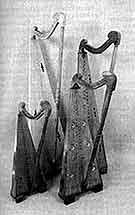














| The Spanish Double [Cross-Strung] Harp, or Arpa de dos ̣rdenes (Abridged) by Hannelore Devaere (Click here for the unabridged version of this article.) "The Christians make such use of [the harp] and teach it to their wives, sons and daughters. Hence it is rare to find a house all of whose indwellers do not skillfully pluck the harp." Thus remarked the Ambassador of Morocco when he visited Spain in 1690-1691. "The persons who most cultivate this instrument are the sons and daughters of the great and noble. It is similarly much in use in their chapels, in their churches, and all those places in which they indulge themselves in their impious acts[!]." |
 Modern Reproduction of the Spanish Double-Harp |
|
One of the earliest collections that we have that refers to the use of
the harp as a solo instrument was assembled in Spain in 1546, and
mentions a certain Ludovico, who was probably an Italian virtuoso in the
service of King Ferdinando V of Aragon. He played a diatonic, or
single-row, harp on which the semi-tones had to be made artificially.
Juan Bermudo wrote in 1555: "I was told that the named Ludovico,
whenever he played a cadence, placed a finger under the string and thus
made it sound as a semitone . Great ability was required to do that."
For many years he and other performers had devised this and other ways
of handling chromatic notes: retuning; placing of nails, fingers, or
tuning keys against the top or bottom of the string; or simply omitting
the chromatic note altogether. Help was on the way! Perhaps as early as 1555, but certainly by 1616, Spanish harp builders were also producing instruments with two sets of strings, one diatonic and one chromatic, that crossed, although there may sometimes have been only a few of the chromatic strings, enough to serve in playing cadences. The Moroccan ambassador describes the Spanish arpa de dos ordenes as being "a large wooden instrument as high as a man and having about 46 strings." Because of its height and the resulting high crossing of the strings, the harpist stands while playing it. The right hand usually plays above the crossing of the strings, near the neck of the harp, thus producing a clear, crystal-like sound. The left hand usually plays the bass strings, touching them in the middle of the instrument under the crossing of the strings, producing a warm round sound quite different from the treble. This sound difference is characteristic of the arpa de dos ordenes. As on other historical harps, the fourth (ring) finger is hardly ever used. The gut strings of historical harps are much thinner and more narrowly spaced, and have less tension, than on a modern harp, so one must use as authentic a playing technique as possible. It is a good idea to study with a historical harpist or from a relevant text. Now, almost 300 years later, we can enjoy a revival of the arpa de dos ordenes.Several historical harpmakers are building excellent replicas of the surviving instruments and of paintings, together with their own new designs. |
|
| [To author biography] | [To complete text.] | [Back to top of page] |
Historical Harp | Folk and World Harp | Pedal Harp |
Harp Building | Harp Works | Non-Harps |
Camps & Concerts | Links | Glossary |
Donate! | Get Involved! | Contact Us | About Harp Spectrum
Copyright 2002 - 2017, Harp Spectrum All Rights Reserved